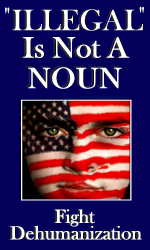Burma?, Pakistan? ... no, Calexico Calif.
 On Sunday, participants in a week-long protest against further militarization of the southern border and further construction of the border wall came under attack from US Border Patrol officers at the Calexico/Mexicali port of entry. The protest, which took place on both sides of the border simultaneously, appeared to have been proceeding peacefully until a symbolic "cross-border kissing booth", which involved making a hole in the border fence approximately four inches in diameter, was installed along the barrier. With that, approximately 100 Border Patrol officers descended upon the 30 demonstrators of "No Borders Camp" with pepper gas pellets, tazers, and batons. In the ensuing melee, three were arrested; many more were injured or suffered from the effects pepper gas.
On Sunday, participants in a week-long protest against further militarization of the southern border and further construction of the border wall came under attack from US Border Patrol officers at the Calexico/Mexicali port of entry. The protest, which took place on both sides of the border simultaneously, appeared to have been proceeding peacefully until a symbolic "cross-border kissing booth", which involved making a hole in the border fence approximately four inches in diameter, was installed along the barrier. With that, approximately 100 Border Patrol officers descended upon the 30 demonstrators of "No Borders Camp" with pepper gas pellets, tazers, and batons. In the ensuing melee, three were arrested; many more were injured or suffered from the effects pepper gas.
One witness said, "I think that people should really understand that the border is a totally militarized zone and that this isn't your normal police repression at a demonstration. This is an occupation force … And that is the real context of what happened today, rather than simple policing"
As people attempted to disperse, the border patrol chased and detained groups of them, forcing them to their knees with their hands on their heads. In one case, a person badly injured by pepper pellets shot at close range was pursued away from the conflict, pulled away from a companion wanting to treat his wounds, surrounded and beaten in the head with batons by up to 15 border patrol agents
IndyMedia
The video tells the whole story. It doesn't look all that dissimilar from what we've seen coming out of police states like Burma or Pakistan recently.
More than 500 people participated in the No Borders Camp during the week of November 7-11. The bi-national camp out was billed as a networking forum for activists opposed to the militarization of the border. Previous No Borders Camps have taken place in Europe and Australia.
Activities during the camp included a rally and march on November 9 at the U.S. Immigration and Customs Enforcement detention facility in El Centro, CA and a memorial service on November 10 at a cemetery in Holtville, CA where the remains of migrants who've died crossing the border are buried. All activities during the camp were peaceful and intended to build connections across borders. Sunday's march was meant to culminate the border camp.
The following interview with an eyewitness gives a detailed account of the confrontation:
Q: This is a quick report back from what happened at the border, go ahead and give us your version of what happened, what you saw.
A: The cops really didn't like the bi-national kissing booth, thats for sure. The holes that were put in the wall to set up the kissing booth were in my view the instigation of the actual initial push to separate us from the wall.
The cops formed a line on the Calexico side which separated us from that wall. At that point there was a quick rally and a lot more border patrol showed up.
Two things happened:
One, an officer claimed that he was pushed or in some way "assaulted." I didn't see what happened.
And bottles started to come over the wall from the Mexicali side.
But pretty suddenly and a pretty unprovoked attack followed from there in which a lot of border patrol made a huge push forward to push us out of the entire square.
People who fell down were mostly hit; some were beaten quite badly.
A group of us were surrounded on one side and detained, told to sit down and put our hands on our heads.
We were detained for a brief period of time and eventually released in fives.
That's pretty much what happened.
Q: When did you hear the order to disperse? When did they give that order?
A: There was never any order to disperse. It was totally a surprise when the attack came.
Q: How many people did you see were arrested, did you see anybody get arrested?
A: I saw three people who looked like they were being taken into custody and those people seemed to me to be the ones that had fallen down.
Q: You were saying earlier before we started the recording that you saw one person who was pushed over when the line came in and they were just beaten. I hate to ask you but can you kind of describe that scene?
A: One of the people on the Calexico side was pushed over and he was on the ground, he was covering his head,as he tried to stand up, the border patrol kept hitting him in the knees with batons, repeatedly in the knees. I saw one blow to the face. He looked completely passive, he was not resisting and he has been taken into custody.
Q: Anything else you can recall from that, did you have any chance to interact with the border patrol officers,
was there any communication between the people there and them?
A: The communication was extremely limited. There was a real unwillingness on the part of the border patrol to work with our legal observers. it was actually quite a while before our legal observers were given the time of day.
It was quite a while before our legal observers were given the time of day. Basically the orders seemed to be coming from this one officer who claimed he was pushed or "assaulted." I don't believe that at all, i think it was a totally premeditated attack, but that's just me.
Q: How does this compare to other things you have experienced, how does this compare to your past experience?
A: The thing about the border patrol, we were in a zone that is completely militarized. The border patrol are not cops, they are essentially a military, and an occupation force, so they don't actually even really know or understand protocols for police interactions with mass movements.
There was actually an extreme ignorance on the part of the border patrol for even basic issues of protocol for how to deal with the situation and a lot of the border patrol were acting like this was their first time. They didn't form straight lines when they lined up, when they started pushing they didn't push in a straight lineup, they just went into the crowd fists swinging. It was very undisciplined and it was very emotional and then when we were all sitting down they would yell things at us and talk to us in the most bizarre way.
Q: As an example?
A: As an example, one of the border patrol came over to one of the groups and started saying like how something about how we were... The border patrol agent was basically just trying to explain to us how what we were doing was wrong. That was just a really strange thing for a cop to do. We were all on our knees with our hands behind our heads. Now he is going to come over to us and lecture us about our politics, which he doesn't even understand, and he did it in a very bizarre way which I can't even recall right now.
Q: I recall that the border patrol had some sort of special training session right before this. Maybe that was to make them have some sort of policing skills.
A: I think it was probably more how to learn how to use the paint ball pepper spray pellet guns the people who were armed with those did seem they did have training in how to use them, the paint ball pepper spray pellets normally should hit the ground so that the gas would rise. It seemed that they were trained in crowd dispersal techniques with that particular weapon.
Q: But in one case we've seen photos on the website now with at least one person was shot several times in the body?
A: Yeah, three or four times to the chest that is another bizarre exception to the kinds of things we've been seeing.
Q: Do you think it would be fair to say that they might have been itching for a chance to actually do some damage after the actual camp which was more or less peaceful?
A: I think the officer in charge [Mario Lacuesta], absolutely, this is really what I think that was about. Because the officer in charge, he was the last officer to come in on the shift change and when he came in for the shift change at the no borders camp, he immediately started causing problems at the camp, he immediately reversed decisions that previous officers had made in terms of camp protocol, and was really provocatory even during the No Borders Camp itself.
And then for him to come at us and to try to say that he was attacked it was definitely like he was trying to affirm relationship that he had established and initiated in the No Borders Camp.
If he's right, if he wasn't lying, if he really was the instigator of this total violent act of oppression, then this is totally continuous. Yeah, it's payback.
Q: Is there anything else that you think is important?
A: I think that people should really understand that the border is a totally militarized zone and that this isn't your normal police repression at a demonstration.
This is an occupation force protecting its institutional apparatus of occupation. And that is the real context of what happened today, rather than simple policing tactics.
Courtesy of IndyMedia
This is not the first time that law enforcement personnel have overstepped their authority while dealing with demonstrators protesting aspects of US immigration policy. This past May, during a national day of protest for immigrants rights, police in riot gear, armed with batons and guns loaded with no-lethal ammunition entered LA's MacArthur Park and began firing upon the crowd.
When seeing video like the one shot at Calexico, it only confirms just how much our current leadership has in common with the dictatorial police states they support around the world.

































No comments:
Post a Comment